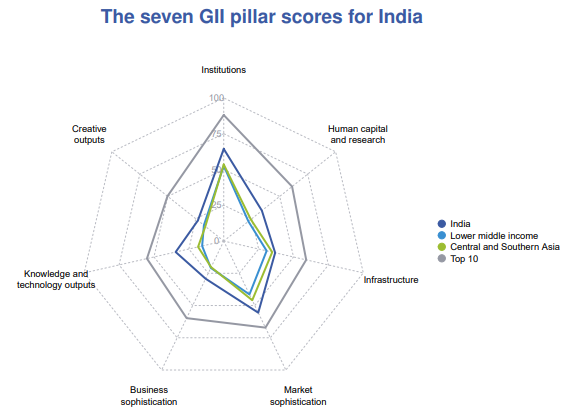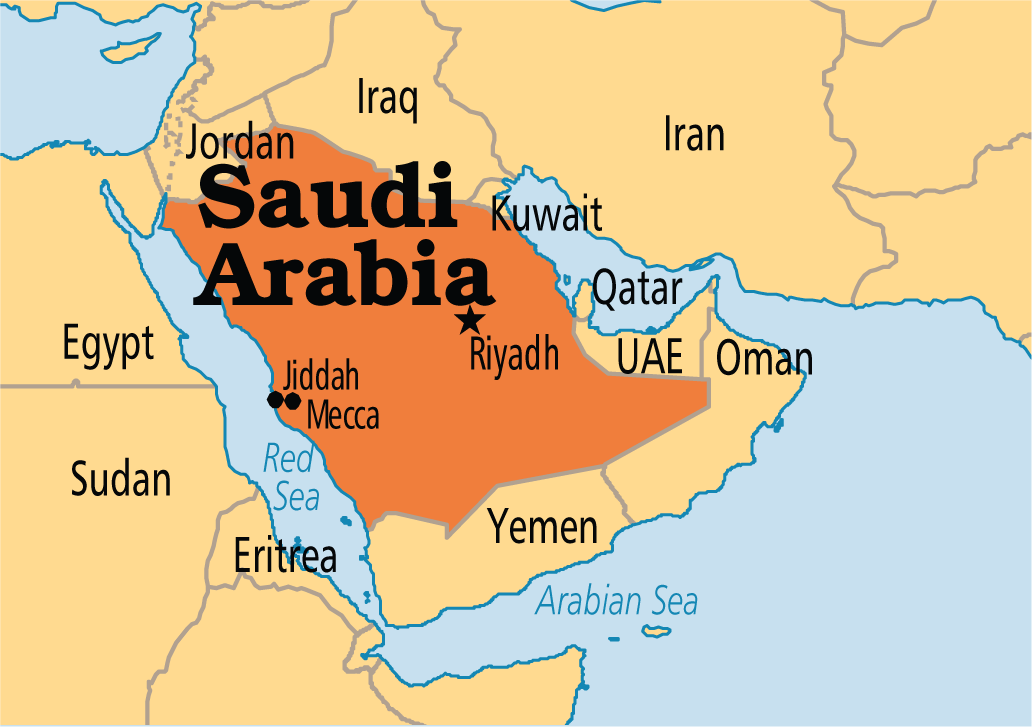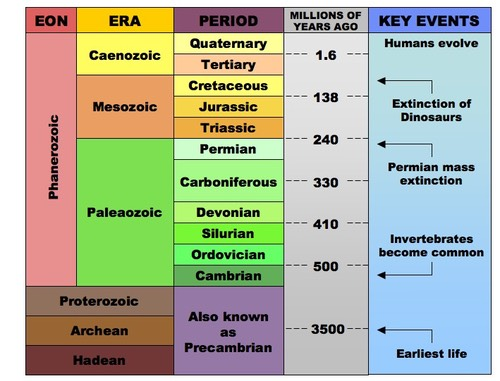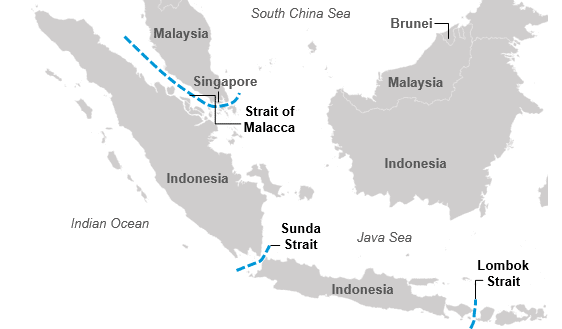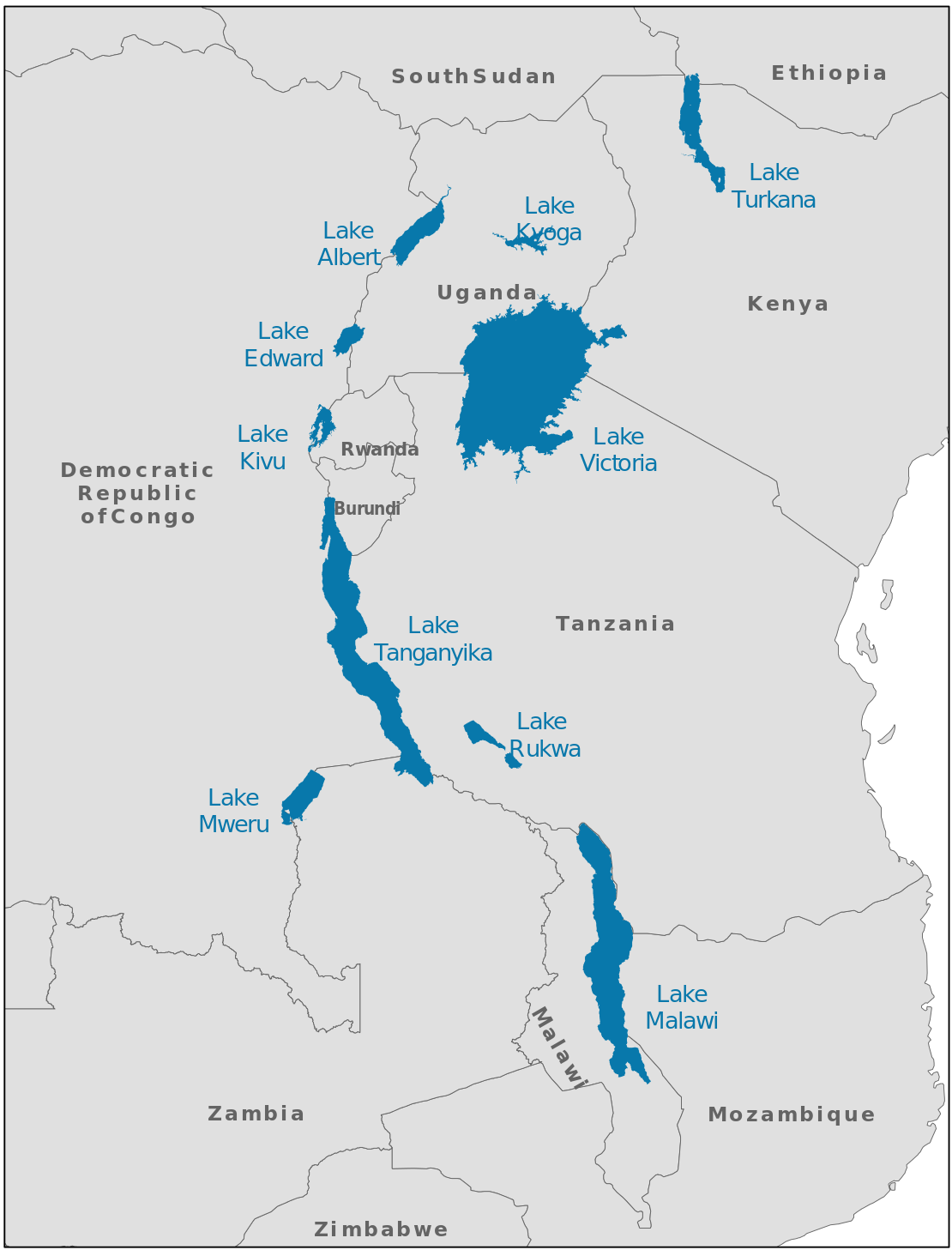Indian Economy
Global Innovation Index 2021
Why in News
Recently, India has climbed two spots and has been ranked 46th in the Global Innovation Index (GII) 2021 rankings.
Key Points
- Global Innovation Index (GII) 2021:
- About:
- Launch: The GII is launched by the World Intellectual Property Organization (WIPO), a specialized agency of the United Nations.
- The GII aims to capture the multi-dimensional facets of innovation ranking and rich analysis referencing around 132 economies.
- Partnership: It is published in partnership with the Portulans Institute and other corporate partners:
- The Brazilian National Confederation of Industry (CNI), Confederation of Indian Industry (CII), Ecopetrol (Colombia) and the Turkish Exporters Assembly (TIM).
- Indicators: The index ranks world economies according to their innovation capabilities and consists of roughly 80 indicators grouped into innovation inputs and outputs.
- Innovation inputs: Institutions; Human capital and research; Infrastructure; Market sophistication; Business sophistication.
- Innovation outputs: Knowledge and technology outputs; Creative outputs
- Launch: The GII is launched by the World Intellectual Property Organization (WIPO), a specialized agency of the United Nations.
- Global Performance:
- Top Five: Switzerland, Sweden, U.S., and U.K. continue to lead the innovation ranking, and have all ranked in the top 5 in the past three years.
- The Republic of Korea joins the top 5 of the GII for the first time in 2021.
- Asian Countries: Four Asian economies feature in the top 15: Singapore (8), China (12), Japan (13) and Hong Kong, China (14).
- Top Five: Switzerland, Sweden, U.S., and U.K. continue to lead the innovation ranking, and have all ranked in the top 5 in the past three years.
- India’s Performance:
- India has been on an upward trajectory over the past few years in the GII.
- India has shot up from a rank of 81 in 2015 to 46 in 2021.
- India performs better in innovation outputs than innovation inputs in 2021.
- This year India ranks 57th in innovation inputs, the same as last year but higher than 2019.
- As for innovation outputs, India ranks 45th. This position is the same as last year but higher than 2019.
- India ranks 2nd among the 34 lower middle-income group economies.
- India ranks 1st among the 10 economies in Central and Southern Asia.
- The government attributed the country’s improved performance to the departments of atomic energy, science and technology, biotechnology and space.
- India has been on an upward trajectory over the past few years in the GII.
- About:
- Other Findings from the GII 2021:
- Investments in innovation reached an all-time high before the pandemic with R&D growing at an exceptional rate of 8.5% in 2019.
- Government budget allocations for the top R&D spending economies showed continued growth in 2020.
- The publication of scientific articles worldwide grew by 7.6% in 2020.
- India, Kenya, the Republic of Moldova, and VietNam hold the record for overperforming on innovation relative to their level of development for the 11th year in a row.
Note
- The India Innovation Index has been developed by NITI (National Institution for Transforming India) Aayog on the lines of the GII.
- The index goes beyond traditional approaches by considering the best parameters in measuring innovation such as patents per million of population, publication in scientific journals, percentage of GDP spending on research.
- It also adds parameters that are specific to the Indian economy (eg. Demographic dividend), to give it a more holistic coverage.
Governance
State Food Safety Index: FSSAI
Why in News
Recently, the Union Minister for Health and Family Welfare has released the 3rd State Food Safety Index (SFSI).
- Also, 19 Mobile Food Testing Vans (Food Safety on Wheels) have been flagged off to supplement the food safety ecosystem across the country.
Key Points
- About the Index:
- The index is developed by FSSAI (Food Safety and Standards Authority of India) to measure the performance of states on five significant parameters of Food Safety.
- The parameters include Human Resources and Institutional Data, Compliance, Food Testing – Infrastructure and Surveillance, Training & Capacity Building and Consumer Empowerment.
- The Index is a dynamic quantitative and qualitative benchmarking model that provides an objective framework for evaluating food safety across all States/UTs.
- The first State Food Safety Index for the year 2018-19 was announced on the first-ever World Food Safety Day on 7th June 2019.
- Ranking of States:
- Among the larger states, Gujarat was the top ranking state, followed by Kerala and Tamil Nadu.
- Among the smaller states, Goa stood first followed by Meghalaya and Manipur.
- Among UTs, Jammu & Kashmir, Andaman & Nicobar Islands and New Delhi secured top ranks.
- Importance of Food Safety:
- Access to sufficient amounts of safe food is key to sustaining life and promoting good health.
- Foodborne illnesses are usually infectious or toxic in nature and often invisible to the plain eye, caused by bacteria, viruses, parasites or chemical substances entering the body through contaminated food or water.
- An estimated 4,20,000 people around the world die every year after eating contaminated food and children under 5 years of age carry 40% of the foodborne disease burden, with 1,25, 000 deaths every year.
- Food safety has a critical role in assuring that food stays safe at every stage of the food chain - from production to harvest, processing, storage, distribution, all the way to preparation and consumption.
- Food production is responsible for up to 30% of global greenhouse-gas emissions contributing to global warming.
- Access to sufficient amounts of safe food is key to sustaining life and promoting good health.
- Related Initiatives:
- Indian:
- Eat Right India Movement:
- It is an initiative of the Government of India and FSSAI to transform the country’s food system in order to ensure safe, healthy and sustainable food for all Indians.
- It is aligned to the National Health Policy 2017 with its focus on preventive and promotive healthcare and flagship programmes like Ayushman Bharat, POSHAN Abhiyaan, Anemia Mukt Bharat and Swachh Bharat Mission.
- Eat Right Station Certification:
- The certification is awarded by FSSAI to railway stations that set benchmarks (as per the Food Safety and Standards Act, 2006) in providing safe and wholesome food to passengers.
- The Eat Right Research Awards and Grants to encourage and recognize high-quality research in the area of food safety and nutrition in India has also been launched.
- The results of PAN-India survey for identifying the presence of industrially produced trans fatty acid content in the selected foods has been released. Overall, only 84 samples, i.e. 1.34%, have more than 3% industrially produced trans fats from the total of 6245 samples.
- In an effort to engage industry on the issue of plastic in food packaging, 24 food businesses signed a pledge on becoming “Plastic Waste Neutral” by collecting, processing and recycling of 100% post-consumer plastic waste from across the sources.
- Eat Right India Movement:
- Global:
- The Codex Alimentarius, or "Food Code" is a collection of standards, guidelines and codes of practice adopted by the Codex Alimentarius Commission.
- The Codex Alimentarius Commission is a joint intergovernmental body of the Food and Agriculture Organization (FAO) and World Health Organization (WHO).
- Currently, it has 189 members and India is a member.
- Indian:
Social Justice
Forest Rights Act
Why in News
Recently, the Jammu and Kashmir government has decided to implement the Forest Rights Act (FRA), 2006, which will elevate the socio-economic status of a sizable section of the 14-lakh-strong population of tribals and nomadic communities.
Key Points
- About:
- FRA enacted in 2006 recognises the rights of forest-dwelling tribal communities and other traditional forest dwellers to forest resources on which these communities were dependent for a variety of needs, including livelihood, habitation and other sociocultural needs.
- It recognizes and vest the forest rights and occupation in Forest land in Forest Dwelling Scheduled Tribes (FDST) and Other Traditional Forest Dwellers (OTFD) who have been residing in such forests for generations.
- It strengthens the conservation regime of the forests while ensuring livelihood and food security of the FDST and OTFD.
- The Gram Sabha is the authority to initiate the process for determining the nature and extent of Individual Forest Rights (IFR) or Community Forest Rights (CFR) or both that may be given to FDST and OTFD.
- Rights Under the Forest Rights Act:
- Title rights:
- It gives FDST and OTFD the right to ownership to land farmed by tribals or forest dwellers subject to a maximum of 4 hectares.
- Ownership is only for land that is actually being cultivated by the concerned family and no new lands will be granted.
- Use rights:
- The rights of the dwellers extend to extracting Minor Forest Produce, grazing areas etc.
- Relief and development rights:
- To rehabilitate in case of illegal eviction or forced displacement and to basic amenities, subject to restrictions for forest protection.
- Forest management rights:
- It includes the right to protect, regenerate or conserve or manage any community forest resource which they have been traditionally protecting and conserving for sustainable use.
- Title rights:
- Significance:
- Constitutional Provision Expansion:
- It expands the mandate of the Fifth and the Sixth Schedules of the Constitution that protect the claims of indigenous communities over tracts of land or forests they inhabit.
- Security Concerns:
- The alienation of tribes was one of the factors behind the Naxal Movement, which affected states like Chhattisgarh, Odisha and Jharkhand.
- Forest Governance:
- It has the potential to democratise forest governance by recognising community forest resource rights.
- It will ensure that people get to manage their forest on their own, which will regulate exploitation of forest resources by officials, improve forest governance and better management of tribal rights.
- Constitutional Provision Expansion:
- Challenges:
- Administrative Apathy:
- As tribals are not a big vote bank in most states, governments find it convenient to subvert FRA or not bother about it at all in favour of monetary gains.
- The forest bureaucracy has misinterpreted the FRA as an instrument to regularise encroachment instead of a welfare measure for tribals.
- Corporates fear they may lose the cheap access to valuable natural resources.
- Dilution of Act:
- Certain sections of environmentalists raise the concern that FRA bends more in the favour of individual rights, giving lesser scope for community rights.
- Institutional Roadblock:
- Rough maps of community and individual claims are prepared by Gram Sabha which at times often lack technical knowhow and suffers from educational incapacity.
- Misuse of FRA:
- The FRA has been misused and communities have rushed to file claims. Politicians across party lines have interpreted FRA as a land distribution exercise and have fixed targets for districts.
- Administrative Apathy:
Way Forward
- It is important that the governments at Central and State levels are strengthened with human and financial resources to help implement FRA on a mission mode.
- Besides leveraging modern technology to map and monitor the implementation of FRA, the forest bureaucracy must also be reformed to serve as service providers to gram sabhas.
Governance
Curb on Foreign Funding of NGOs
Why in News
Recently, the Union Government has put restrictions on funding for 10 international Non-Governmental Organisations (NGO’s) working on Child Rights, Climate Change and environmental projects.
- In February 2021, the Ministry of Home Affairs (MHA) issued new regulating guidelines to banks under Foreign Contribution (Regulation) Act, 2010.
Key Points
- About:
- The Reserve Bank of India had previously asked for several foreign organisations to be put on the Prior Reference Category (PRC) list.
- It implies that as and when the foreign donor wants to transfer the money to some recipient association in India, the same needs prior clearance from the Ministry of Home Affairs.
- Over 80 international agencies are on the list.
- The Reserve Bank of India had previously asked for several foreign organisations to be put on the Prior Reference Category (PRC) list.
- Provisions Under FCRA Amendment, 2020:
- It requires any organisation that wants to register itself under the FCRA to have existed for at least three years and to have spent a minimum of Rs 15 lakh on its core activities during the last three financial years for the benefit of the society.
- The NGOs are also required to submit commitment letters from their donors, specifying the amount of foreign contributions and the purpose for which they are proposed to be given.
- Reasons for Curb:
- It was stated that dozens of NGOs were indulged in outright misappropriation or misutilisation of foreign contributions.
- Even doubling the inflow of foreign contribution between the years 2010 and 2019, many recipients have not utilised the fund for the purpose for which they were registered or granted under FCRA Act.
- It has also led the central government to cancel certificates of registration of more than 19,000 recipient organisations during the period between 2011 and 2019.
- Implications:
- Discouraging Constitutional Rights:
- These moves will have a discouraging effect on the constitutionally guaranteed rights to freedom of association, expression and assembly (Article 19).
- The government has expanded governmental discretion, bureaucratic control and oversight with respect to the day-to-day functioning of NGOs in India.
- Can Curb NGOs’ Humanitarian Work:
- It can choke NGOs with red tape so that they are unable to do their humanitarian work.
- It can make it more difficult for grassroots NGOs that are independent of government, business, religion and political groups to operate in India.
- Repressing Freedom:
- The passage of the FCRA Amendment, 2020 and the actions against Amnesty place India next to only Russia, where the government has used the Foreign Agents Law, 2012 and Undesirable Organisations Law, 2015 as a weapon to repress freedom of association and expression.
- International organisations had expressed concern over the use of the Foreign Contribution Regulation Act to “stifle the voices” of activists and non-governmental organisations in India.
- Discouraging Constitutional Rights:
Way Forward
- Excessive regulation on foreign contribution may affect working of the NGOs which are helpful in implementing government schemes at the grassroots. They fill the gaps, where the government fails to do their jobs.
- The regulation should not hamper sharing of resources across national boundaries essential to the functioning of a global community, and should not be discouraged unless there is reason to believe the funds are being used to aid illegal activities.
Science & Technology
Role of Rice in Boosting Nourishment
Why in News
According to a recent study, as many as 12 folk varieties of Indian rice examined by researchers can supplement the nutritional demand of important Fatty Acids (FA) in undernourished mothers.
- Rice contains various classes of fatty acids, vitamins, minerals, starch and a small amount of protein.
Key Points
- Fatty Acids:
- Fatty acids are natural components of fats and oils. These have many important functions in the body, including energy storage.
- Based on their chemical structure they can be differentiated into three groups: ‘saturated’, ‘mono-unsaturated’ and ‘poly-unsaturated’ fatty acids.
- Saturated fatty acids (fats) are mainly found in animal foods, such as (fatty) meat, lard, sausage, butter and cheese but even in palm kernel and coconut oil, which are used for frying.
- Most unsaturated fatty acids (fats) are of plant and fatty fish origin. Meat products contain both saturated and unsaturated fats.
- Within the family of PolyUnsaturated Fatty Acids (PUFAs), there are two different groups: the ‘omega-3-fatty acids ‘and ‘omega-6-fatty acids’.
- Both are considered essential fatty acids because they cannot be synthesized by humans.
- Trans fatty acids, more commonly called trans fats, are made by heating liquid vegetable oils in the presence of hydrogen gas and a catalyst, a process called hydrogenation. These are the worst types of fat for the heart, blood vessels, and rest of the body.
- Findings of the Study:
- Helpful for Health:
- The traditional rice varieties can add essential FAs in the staple diet helping in the normal brain development in infants.
- Many folk varieties like Athikaraya, Dudh-sar, Kayame, Neelam samba, Srihati, Maharaji and Bhejri are known in folk medicine to enhance milk production in lactating women.
- Varieties like Kelas, DudheBolta and Bhutmoori are rich in iron and can be included in the diet of mothers to treat anaemia.
- Address the Problem of Undernutrition:
- The traditional varieties help address the problem of undernutrition in under five children.
- India was placed at the 94th spot among 107 countries by the Global Hunger Index 2020. It is calculated on the basis of total undernourishment of the population, child stunting, wasting and child mortality.
- Contributes to the Economy:
- Recently, the first export consignment of Bao-dhaan (red rice) from Assam was sent to the US in March 2021. This enhances incomes of farming families.
- This iron-rich red rice is grown in the Brahmaputra valley of Assam, without the use of any chemical fertilizer.
- Recently, the first export consignment of Bao-dhaan (red rice) from Assam was sent to the US in March 2021. This enhances incomes of farming families.
- Resistance against Disease:
- Seven rice varieties of North East India — Meghalaya lakang, Chingphourel, Manuikhamei, Kemenyakepeyu, Wainem, Thekrulha, and Koyajang — have the potential to resist leaf and neck blast disease in rice plants.
- Blast disease caused by fungal pathogen Pyricularia oryzae is a major threat to rice productivity worldwide.
- Seven rice varieties of North East India — Meghalaya lakang, Chingphourel, Manuikhamei, Kemenyakepeyu, Wainem, Thekrulha, and Koyajang — have the potential to resist leaf and neck blast disease in rice plants.
- Conservation is Cheaper:
- In situ conservation of these neglected and vanishing varieties of rice, rich in nutrients, is a cheaper option than High-Yielding Varieties (HYVs).
- HYV seeds were developed by scientists to improve food supplies and reduce famine in developing countries.
- In situ and ex situ conservation focuses on the maintenance of species diversity within or away from their natural habitats, respectively.
- In situ conservation of these neglected and vanishing varieties of rice, rich in nutrients, is a cheaper option than High-Yielding Varieties (HYVs).
- Helpful for Health:
Rice
- It is a kharif crop which requires high temperature, (above 25°C) and high humidity with annual rainfall above 100 cm.
- Rice is grown in the plains of north and north-eastern India, coastal areas and the deltaic regions.
- West Bengal tops the list of rice-producing states followed by Uttar Pradesh and Punjab.
International Relations
Saudi Arabia Foreign Minister’s Visit
Why in News
Recently, the Indian External Affairs Minister met the Foreign Minister of the Kingdom of Saudi Arabia.
Key Points
- About the Meeting:
- Cooperation in Multilateral Forums: Discussed bilateral cooperation in multilateral forums such as the United Nations, G-20 and Gulf Cooperation Council (GCC).
- India is not a member of GCC.
- Implementation of the Strategic Partnership Council Agreement (signed in 2019):
- India-Saudi Strategic Partnership Council was formed to coordinate on strategically important issues.
- The council will be headed by the Prime Minister and Crown Prince Mo hammed and will meet every two years.
- India is the fourth country with which Saudi Arabia has formed such a strategic partnership, after the UK, France and China.
- Saudi Arabia has been a strategic partner of India since the signing of the Riyadh Declaration in 2010.
- India-Saudi Strategic Partnership Council was formed to coordinate on strategically important issues.
- Focus on the Developments in Afghanistan and Other Regional Issues: Saudi Arabia, along with Pakistan and the UAE, were the key backers of the Taliban regime that ruled Kabul from 1996 till 2001 when they were ousted by US-led international troops.
- Strengthening Partnership: Discussed further steps to strengthen their partnership in trade, investment, energy, defence, security, culture, consular issues, health care, and human resources.
- Cooperation in Multilateral Forums: Discussed bilateral cooperation in multilateral forums such as the United Nations, G-20 and Gulf Cooperation Council (GCC).
- India - Saudi Arabia Ties:
- Crude oil Supplier: Saudi Arabia is currently India’s second-largest supplier of crude oil (Iraq has been India's top supplier).
- Saudi Arabia is keen to play a role in the creation of Strategic Petroleum Reserves (SPRs) at Padur in Karnataka.
- A study is being conducted for the setting up of the world’s largest greenfield refinery at Raigarh in Maharashtra by Saudi Aramco, Adnoc of the United Arab Emirates and Indian public sector oil companies.
- Bilateral Trade: Saudi Arabia is India’s fourth largest trade partner (after China, USA and Japan). The bilateral trade was valued at US $33.07 billion during FY 2019-20.
- During the same period, India's imports from Saudi Arabia reached US $26.84 billion and exports to Saudi Arabia were worth US$ 6.24 billion registering an increase of 12.18% over last year.
- Indian Diaspora: The 2.6 million-strong Indian community in Saudi Arabia is the largest expatriate community in the Kingdom and is the ‘most preferred community’ due to their expertise, sense of discipline, law-abiding and peace-loving nature.
- Cultural Linkages: Haj pilgrimage is another important component of bilateral relations between India and Saudi Arabia.
- Naval Exercise: Recently, India and Saudi Arabia started their first-ever Naval joint exercise called the Al-Mohed Al-Hindi Exercise.
- Crude oil Supplier: Saudi Arabia is currently India’s second-largest supplier of crude oil (Iraq has been India's top supplier).
Way Forward
- The trade balance between India and Saudi Arabia is highly in favour of Saudi Arabia, and India's exports are mainly restricted to the agricultural sector. There is a need for India to increase its product base to balance the trade in its favour.
- The potential areas for the next stage of bilateral cooperation could be infrastructure, energy, skilling and IT.
- Further, India should convince Saudi Arabia to exercise its influence over Pakistan in controlling the Taliban in Afghanistan.
- A joint collaborative effort of both economies will transform the Southwest Asia sub-region.
Indian Economy
Promoting Pearl Farming in Tribal Areas: TRIFED
Why in News
Recently, the TRIFED (Tribal Cooperative Marketing Development Federation of India) inked an agreement with the Jharkhand-based Purty Agrotech for the promotion of pearl farming in tribal areas.
Tribal Cooperative Marketing Development Federation of India
- It is a national-level apex organization functioning under the administrative control of the Ministry of Tribal Affairs. It came into existence in 1987.
- It has its Head Office located in New Delhi and has a network of 13 Regional Offices located at various places in the country.
- Its main objective is socio-economic development of tribal people in the country by way of marketing development of the tribal products such as metal craft, tribal textiles, etc.
- It mainly undertakes two functions viz. Minor Forest Produce (MFP) development and Retail Marketing and Development.
Key Points
- About:
- As part of the agreement, Purty Agrotech pearls will be sold through 141 Tribes India outlets, apart from various e-commerce platforms.
- Purty Agrotech’s centre will be developed into a Van Dhan Vikas Kendra Cluster (VDVKC). Besides, there is a plan to develop 25 such VDVKCs for pearl farming in Jharkhand.
- VDVKs provide skill upgradation and capacity building training to tribals and setting up of primary processing and value addition facilities.
- The TRIFED has also signed an MoU with e-grocery platform Big Basket to promote and sell natural ‘Van Dhan’ products.
- The breeding of oysters and development of pearls is a sustainable mode of business and can be easily practised by tribals who have access to nearby water bodies.
- It will prove to be game-changers for tribal livelihoods in the times to come.
- Pearl Farming:
- Pearls are the only gemstones in the world that come from a living creature. Mollusks such as oysters and mussels produce these precious jewels that people have adored since ancient times.
- Pearl oysters are farmed in a number of countries in the world in the production of cultured pearls.
- Freshwater pearls are pearls that are grown on pearl farms using freshwater mussels. Since mussels are the organic hosts, the pearls can grow up to 10 times bigger than those made by saltwater oysters, naturally. And, the luster freshwater pearls produce is astounding.
- Pearls are the only gemstones in the world that come from a living creature. Mollusks such as oysters and mussels produce these precious jewels that people have adored since ancient times.
- Benefits:
- Increased Farmers Income: The income of farmers in India is usually dependent on external factors like climate and this dependence often leads to their losses but on the other hand, Pearl farming is totally independent of these factors and gives one a high amount of profit.
- Eco-Friendly: Pearl farming is eco-friendly. It provides habitat for fish and improves species diversity.
- Water Purification: Filter feeder oysters also purify the water. A single oyster clears over 15 gallons of water a day.
- It accumulates heavy metals from the water, and removes harmful pollutants as well.
- Initiatives Taken:
- Pearl farmers can get benefits under PMMSY (Pradhan Mantri Matsya Sampada Yojana).
- Considering the scope of pearl farming, the Department of Fisheries has included a sub-component for pearl culture in the Blue Revolution scheme for encouraging the sector.
Important Facts For Prelims
New Species of Hybodont Shark
Why in News
Recently, the Geological Survey of India (GSI) and the Indian Institute of Technology, Roorkee have discovered a new extinct species of hybodont shark from the Jaisalmer Basin of Rajasthan.
- GSI is a scientific agency under the Ministry of Mines, works as a repository of geo-science information required in various fields in the country.
Key Points
- Newly discovered species:
- The newly discovered crushing teeth from Jaisalmer represents a new species named by the research team as Strophodusjaisalmerensis.
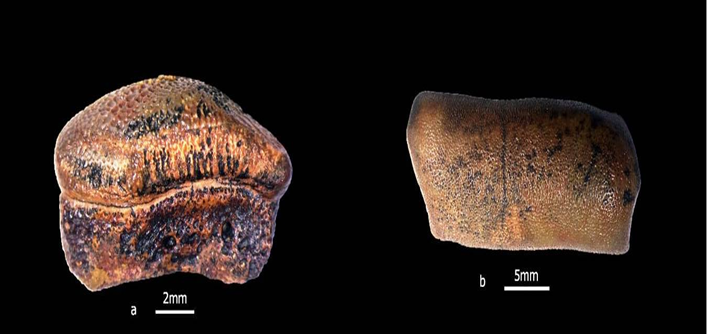
- The genus Strophodus has been identified for the first time from the Indian subcontinent and is only the third such record from Asia, the other two being from Japan and Thailand.
- These sharks have been reported for the first time from the Jurassic rocks (approximately, between 160 and 168 million years old) of the Jaisalmer region of Rajasthan.
- The newly discovered crushing teeth from Jaisalmer represents a new species named by the research team as Strophodusjaisalmerensis.
- Hybodont Sharks:
- Hybodonts dominated both marine and freshwater environments during the Triassic and early Jurassic periods.
- However, hybodont sharks started to decline in marine environments from the Middle Jurassic onwards until they formed a relatively minor component of open-marine shark assemblages.
- They finally became extinct at the end of the Cretaceous time 65 million years ago.
- Significance of the fossil:
- It marks an important milestone in the study of Jurassic vertebrate fossils in the Jaisalmer region of Rajasthan, and it opens a new window for further research in the domain of vertebrate fossils.
- Geological Time Scale:
Important Facts For Prelims
Exercise Samudra Shakti
Why in News
The third edition of maritime exercise ‘Samudra Shakti’ between India and Indonesia will be conducted from 20th-22nd September, 2021 in the Sunda Strait.
Key Points
- About:
- In pursuance of India’s Act East Policy, Exercise ‘Samudra Shakti’ was conceived in 2018 as a bilateral IN-IDN exercise.
- The exercise aims to strengthen the bilateral relationship, enhance mutual understanding and interoperability in maritime operations between the two navies.
- India’s Participation:
- The participating Indian Navy ships Shivalik and Kadmatt are amongst the latest indigenously designed and built multi-role Guided Missile Stealth Frigate and Anti-Submarine Corvette respectively.
- Indian Navy’s Anti-Submarine Warfare capable Long Range Maritime Reconnaissance Aircraft P8I is also participating in the exercise.
- Other Exercises with Indonesia:
- Garuda Shakti (Military Exercise)
- IND-INDO CORPAT, IND-INDO BILAT (Maritime Exercise)
Note:
- GARUDA is a bilateral air exercise between India and France.
Important Facts For Prelims
Lake Tanganyika: East Africa
Why in News
As per a report by Save the Children (a humanitarian organisation), migration in East Africa’s Burundi in recent years has been seen mainly because of the rapid and significant rise of Lake Tanganyika.
Key Points
- It is the second largest lake in eastern Africa. It covers about 12,700 square miles,
- It is the longest freshwater lake in the world and the second deepest after Lake Baikal in Russia.
- The lake is shared among four countries namely Burundi, Democratic Republic of the Congo (DRC), Tanzania and Zambia
- It is situated on the line dividing the floral regions of eastern and western Africa, and oil palms, which are characteristic of the flora of western Africa, grow along the lake’s shores.
- The largest rivers discharging into the lake are the Malagarasi, the Ruzizi, and the Kalambo. Its outlet is the Lukuga River, which flows into the Lualaba River.
- Rice and subsistence crops are grown along the shores, and fishing is of some significance. Hippopotamuses and crocodiles abound, and the bird life is varied.

